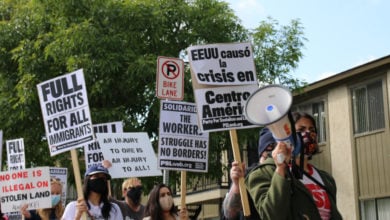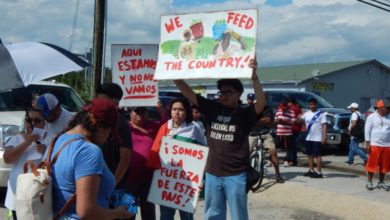Last Friday, Donald Trump eliminated Temporary Protected Status (TPS) for Hondurans in the United States, sending into crisis at least 57,000 Hondurans living here in the United States, some since the 1990s. TPS for Hondurans was initially instituted due to Hurricane Mitch, which killed 7,000 Hondurans in 1998.
This is one decision in a long line of repression against immigrants who have lived here for years: the Trump administration has already eliminated TPS for Salvadorans, Nepalis, Haitians, Nicaraguans, Sudanese, and Liberians, with immigrants from just six countries remaining eligible for this status.
Immigration advocates estimate at least 57,000 Hondurans will lose legal status and will be eligible for deportation at any time. These are people who have lived here sometimes for decades, who have raised families here and are part of the country’s multinational working class.
Trump says TPS was never designed to be permanent. This is true; the name “Temporary Protected Status” makes this clear. But TPS is absolutely crucial until there is comprehensive reform that guarantees full rights for all immigrants.
It should be noted that this wave of racist, anti-immigrant policies like the end of TPS are done at the initiative of the Trump administration, Congressional Democrats had several opportunities to create some broader permanent changes with the passage of a clean DREAM act to protect nearly 2 million young undocumented people, but have not made that a priority — even when there was leverage to do so with government shutdowns several months ago. And even a clean DREAM act wouldn’t have helped the adults who are here legally under TPS.
Why are Hondurans fleeing to the United States?
While the 1998 hurricane was devastating, the broader context that has underlied the uprooting of so many Honduran families to the United States is due to massive violence. At the height in 2012, there were an average of 20 homicides per day. And San Pedro Sula, the second largest city in Honduras, is second in violence only to the world’s war zones. Why is there so much violence?
Honduras’s violence and instability is rooted in its history. Historically, Honduras’ territory has played an important role in U.S. intervention in Central America. In the people’s uprisings in several countries in Central America in the 1980s, the United States took advantage of the Honduran ruling class’ relative stability to use the country as their operating base. The United States set up a military base called Soto Cano, which has been used for decades to train and organize military troops and paramilitary death squads to crush movements and organize coups. Soto Cano has also been used for US torture. The US then used Honduras as its base to combat nearby political movements.
To the west of Honduras, in Guatemala, the US first operated out of Honduras to organize a coup against democratically elected Jacobo Arbenz in 1954 and then again to fight the left-wing guerrilla movements from the 1950s onward.
To the east, in Nicaragua, the Sandinista National Liberation Front took power in 1979 over the US-backed dictatorship. The fascist Contras, death squads supported by the United States, operated out of Honduras and killed over 100,000 people in Nicaragua and Guatemala.
And to the south, in El Salvador, five organizations fought side-by-side as the Farabundo Marti National Liberation Front (FMLN) against the US-backed regime, most intensively from 1979 to 1984.
But then Honduras itself started to move leftward. In 2005, Manuel Zelaya was democratically elected president in Honduras as a moderate reformer. Zelaya started implementing small changes, such as cracking down on corruption. But with popular support and pressure from the people, he moved on to more ambitious measures.
Under Zelaya’s leadership, Honduras joined Bolivarian Alternative of the Americas, a left-wing diplomatic and economic bloc started by the Cuba and Venezuela, and Petro-Caribe, essentially an oil for barter program sponsored by Venezuela to assist development projects in neighboring countries. He pushed for doubling the minimum wage, including at factories for Adidas, Nike, and Gap. In response, those corporations formed an anti-union group, the Worldwide Responsible Apparel Production, to stop anti-sweatshop organizing. Zelaya also called for Soto Cano, the U.S. military base, to close.
The 2009 Coup
In what would be his last move as president, after the public gathered over 600,000 signatures in favor of the creation of a constituent assembly to rewrite the 1982 constitution that had been imposed by the Reagan administration, he called for a non-binding vote to measure interest nationwide. The vote was to be held on June 28, 2009. But on that day, Zelaya was militarily detained and flown out of the country, with a short half-hour stop at Soto Cano before being exiled to Costa Rica. Read more about the coup here.
Before this 2009 coup, the U.S. military had a long history of funding and training the Honduran military. In 1980, US military aid was $3.3 million, but by 1984, it was $77 million, the vast majority of Honduran military spending. Additionally, the Honduran Aviation Academy is on the U.S. military base of Soto Cano — meaning that the pilots who flew President Zelaya out of the country were trained there.
The top two military generals, Luis Javier Prince Suazo and Romeo Vásquez, were both trained at the Western Hemisphere Institute for Security Cooperation, a US-based Department of Defense school in the state of Georgia. Previously known as the School of the Americas, the institute is a notorious training center for torturers and dictators. Vásquez led the military tanks to the capital to physically remove Zelaya.
In addition to long-held control over the nation and its military, President Obama said the Honduran military reported about the possibility of the coup days before it occurred. On June 29, 2009, the day after the coup, the administration said that, “the Honduran military surprised it with Sunday’s coup and that the United States as late as Saturday told the military not to go forward with it.”
If the US was not involved and was not pleased with the outcome, Obama or Hillary Clinton could have called this a military coup (neither ever named it such), pulled their ambassador from the country, or cut off military aid. But with U.S.-trained generals at the helm preventing yet another Central American country from drifting away from the orbit of U.S. imperialism, this was clearly a U.S.-backed action that worked in its favor.
Ousted President Zelaya said the same: “If President Barack Obama really wants to turn back this coup, these coup leaders will last all of five minutes because the economy of Honduras, all our military, commercial and migration activities, depend on the United States.”
It was this rupture in the democratic order, and the replacement of a government committed to progressive policies with one committed to just the opposite, that created the social chaos in which violence and insecurity have spiraled out of control. Honduran immigrants in the United States who lose their Temporary Protected Status and are subsequently deported will face extreme danger that is a creation of U.S. imperialism.
Elections and Political Violence Since the Coup
After Zelaya was exiled on June 28, 2009, Roberto Micheletti was installed by the military as president. Mass protests erupted nationwide and a new people’s movement started, the National Front of Popular Resistance (FNRP), despite heavy political violence directed against them. On June 5, when President Zelaya tried to fly back into Honduras, people waited in droves to meet him as he came in. However, the military blocked the runway and forced the plane to divert. Then they shot into the crowd, which was at least 200,000 strong.
While Micheletti was in office for five months, over 270 human rights violations occurred. On August 12, 2009, people marched from all over Honduras to the capital, Tegucigalpa, where they rallied in front of congress. The military fired on them with tear gas and live ammunition. During Micheletti’s time in office, at least 20 activists were murdered and thousands were incarcerated.
To try to mollify the people and to legitimize the power grab, Micheletti announced elections on Nov. 29, which were highly boycotted, including by 30-40 candidates who themselves withdrew. Porfirio Lobo was installed at that time, in early 2010 (after democratically losing to Zelaya in 2005). In just the first several months of Lobo’s rule, 36 activists and leaders were murdered, and at least 50 more people died in political violence. In resistance, approximately 1.2 million signatures in a population of 8 million were collected in support of a constituent assembly.
Then in 2014, Juan Orlando Hernández took the presidency in yet another contested election marred by blatant fraud. Hernández was reelected in 2017 despite the constitution having a one-term limit. The opposition was leading in the vote count until there were “technical failures” and a substantial delay in the electronic vote count. Once back online, the opposition’s lead miraculously disappeared.
Protests have continued since then, and political violence has only gotten worse. Reports have at least 30 dead in late 2017 protests by the military. Several were young men with autopsies showing bullets only in the back of their bodies. In the 2018 World Press Freedom Index, Reporters Without Borders ranked Honduras 141 out of 180 countries, due to dangers for journalists like physical attacks, threats, and abusive legal proceedings.
The newly appointed head of the military, Rene Ponce, was trained in the United States. The U.S. government’s only response to the recent political violence has been asking “all Hondurans to refrain from violence.”
It is clear that the main threat was never a hurricane, but has always been U.S.-influenced and sponsored terrorism of its people. When Trump uses as a rhetorical reason the 1998 hurricane to end TPS, it’s an excuse to end the program he doesn’t want to support. Honduran immigrants have fled the situations that U.S. imperialism has created and supported. As the Honduran people continue their just fight to free their country from dictatorship, it is essential that we continue the struggle to reinstate TPS.





